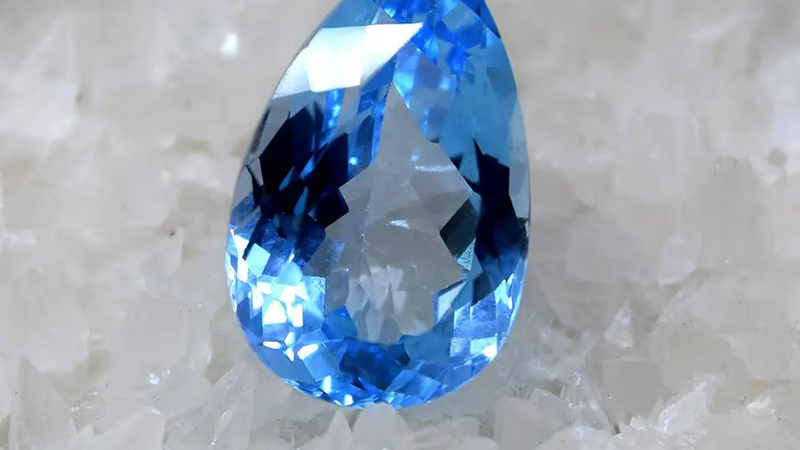
Topaz mining regions showcase diverse colors and qualities.
Brazil is one of the largest producers of topaz in the world. The state of Minas Gerais is particularly renowned for its topaz mines, with Ouro Preto and Capão da Lapa being important mining areas. Brazil produces a wide range of topaz colors, including blue, pink, and yellow. Russia is another significant producer of topaz. The Ural Mountains region, specifically the Murzinka mine in the Sverdlovsk Oblast, is known for its high-quality topaz. Russian topaz is often found in colors ranging from colorless to pale blue and pink.
Nigeria is known for its fine blue topaz. The Jos Plateau, located in the central part of the country, is a notable topaz mining region. Nigerian topaz is admired for its intense blue color and good transparency. Pakistan is a notable source of topaz, particularly for pink and clear varieties. The Shigar Valley in the Skardu district of Gilgit-Baltistan is known for producing pink topaz. The Katlang area in the Mardan district is famous for its clear and colorless topaz.
Topaz is formed in mountainous and volcanic areas and is cooled by magma flows. Gemstones such as pegmatite, rhyolite, and granite are formed in crevices and holes. Although Brazil is known as the main source of topaz, it can be found in Sri Lanka, Nicaragua, Texas, and other parts of the world, and has recently been named the state treasure trove of Utah because it is found in the Utah highlands. There are several things to keep in mind when buying topaz. Depending on the color, the cut, the sharpness, and you need to make sure you get the best piece. Here are some tips and tricks for buying topaz.
Namibia is known for its high-quality blue topaz. The Erongo Region, specifically the Usakos and Karibib areas, is a significant source of topaz in the country. Namibian topaz often displays a vibrant blue color and good transparency. Mexico has topaz deposits in various regions. The state of Minas Gerais is known for yellow and blue topaz, while Hidalgo and San Luis Potosi are notable for their pink topaz. Mexican topaz can exhibit a range of colors and is often found in association with other gemstones like amethyst and quartz.
Sri Lanka, historically known as Ceylon, has topaz deposits. The gem-bearing gravels of the Ratnapura district are known for producing topaz, among other gemstones. Sri Lankan topaz is typically found in colors such as yellow, pink, and blue. Australia is home to several topaz deposits. The New England region of New South Wales is known for its topaz mines, particularly in the town of Glen Innes. Australian topaz can display various colors, including blue, yellow, and pink.
Its most famous places are in Schenkenstein ( Schenechken Stein)The mountains of Sri Lanka, Burma, Brazil, the Ural Mountains in Russia and Australia, the mountains of Japan, the Republic of Malagasy, Mexico, Nigeria, Zimbabwe, Namibia, the United States, Northern Ireland, Scotland, and the United Kingdom. The color of the crystals of this mineral in Ireland is light blue.
Myanmar has been a traditional source of topaz. The Mogok region in northern Myanmar is known for producing topaz in various colors, including blue, pink, and yellow. These topaz gemstones are often found alongside other valuable gemstones like rubies and sapphires. Topaz deposits can be found in several states within the United States. Utah is particularly renowned for its topaz mines, with the Thomas Range and the Topaz Mountain being notable locations. Colorado, California, and Texas are also known for topaz production.
-
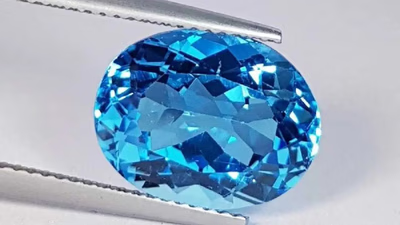
Topaz is a versatile gemstone available in various colors, each with unique properties. Blue topaz, often created through irradiation, is popular for its vibrant hues but is not found naturally. Yellow topaz, abundant and known for its clarity, ranges from pale to deep golden shades. The GIA color grading system categorizes topaz from colorless to black, with several shades including white, golden, pink, champagne, imperial, and magic topaz. White topaz is pure and colorless, while golden topaz includes yellow and orange tones. Pink topaz is rare and typically treated to enhance its color. Champagne topaz features natural brown shades without chemical enhancement. Imperial topaz showcases light peach to dark orange colors and is highly valued.
Magic topaz displays multiple colors due to chemical treatment and is also expensive. Each variety of topaz has distinct characteristics that influence its market value and desirability in jewelry.
-
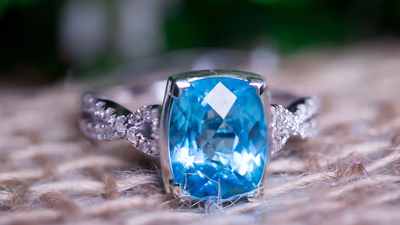
Color, clarity, and cut are the primary factors determining topaz quality. The intensity and saturation of color significantly influence desirability, with vibrant blue and pure pink being highly sought after. Clarity is assessed by the presence of inclusions and blemishes; topaz with minimal flaws is more valuable. Certain varieties, like imperial topaz, may have inclusions that enhance their appeal. Treatments such as irradiation or heat can alter color and clarity, impacting value; untreated stones are generally preferred. The cut of a topaz gemstone affects its brilliance and overall aesthetic, with common shapes including emerald, pear, and oval. While larger stones are rarer and often more valuable, exceptional smaller stones can also command high prices based on their quality attributes. Buyers should consider both the visual appeal and the craftsmanship of the cut when selecting topaz.
-
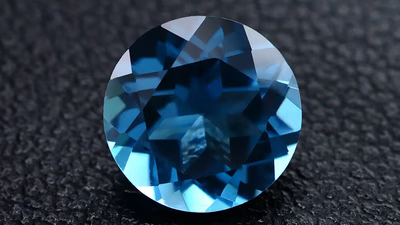
Topaz gemstones should be stored separately to avoid scratches and damage. Use small jewelry bags or soft cloth pouches for individual stones. Exposure to chemicals, such as household cleaners and perfumes, can dull the gemstone"s luster or cause discoloration. Extreme heat and rapid temperature changes can lead to fractures, so it"s essential to keep topaz away from direct sunlight and heat sources. Topaz is a semi-precious stone available in various colors, including light milky shades, gold, yellow, red, and blue. Historically regarded as a symbol of love and affection, topaz is often used in jewelry like necklaces, bracelets, and earrings. To clean topaz, use a solution of hot water and soap with a soft brush or cloth; avoid harsh chemicals or ultrasonic cleaners that may damage the stone. Regular professional cleaning by a jeweler is recommended to maintain its brilliance.
-

Topaz is mined in various regions worldwide, with Brazil leading in production, particularly in Minas Gerais. The country offers a spectrum of colors, including blue, pink, and yellow. Russia"s Ural Mountains are another significant source, known for high-quality topaz in colorless and pale hues. Nigeria"s Jos Plateau is recognized for its intense blue topaz, while Pakistan"s Shigar Valley produces notable pink varieties. Other countries like Namibia and Mexico also contribute to the global topaz market, with Namibia known for vibrant blue stones and Mexico for a range of colors associated with other gemstones. Sri Lanka and Australia have historical significance in topaz mining as well. The mineral forms in mountainous areas through volcanic activity and is often found alongside other gemstones. When purchasing topaz, factors such as color, cut, and clarity are essential to consider to ensure quality. "
-
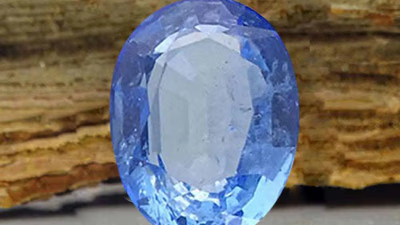
Irradiation and heat treatment are primary methods for enhancing topaz color. Irradiation uses high-energy radiation to transform colorless or pale topaz into various shades of blue, while heat treatment alters yellow, orange, or brown stones into durable pink hues. Coating is a temporary method that applies a colored film to the surface, creating effects like iridescence but is not long-lasting. It"s crucial for sellers to disclose any treatments applied to topaz, as natural variations are also highly valued. The article highlights the importance of recognizing treated versus untreated stones and notes that many blue topazes on the market are heat-treated colorless varieties from Nigeria and Sri Lanka. Additionally, it warns against confusion with other gemstones like citrine and aquamarine, which can be misrepresented as topaz. The rarity of natural pink topaz and the value of golden topaz are also discussed, emphasizing the need for informed purchasing decisions. "





